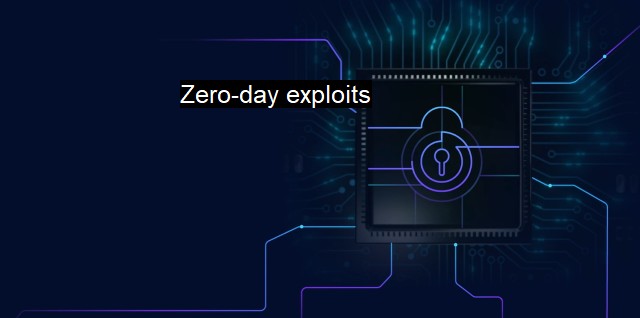What are Zero-day exploits?
The Risks Posed by Zero-Day Exploits: Why Antivirus Software May Not Be Enough
Zero-day exploits are some of the more sophisticated cybersecurity threats in the current environment. These terms are associated often with instances of critical risks observed in computer systems or networks. A zero-day vulnerability signifies a systemic weakness, inconsistency, or glitch that is unknown to the parties accountable for patching or resolving the vulnerability. The term 'zero-day' implies the lack of knowledge regarding the vulnerability, which suggests that developers have 'zero days' to address the problem before the exploit occurs.One fundamental characteristic of a zero-day vulnerability and exploit often concerns its invisibility to cybersecurity defenses, such as Intrusion Prevention Systems (IPS), antivirus software, and other kinds of heuristic-based detection technology. The elusive nature and the unforeseen approach used in zero-day exploits present formidable obstacles for existing security infrastructure.
Zero-day exploits capitalize on such vulnerabilities before they're recognized by the concerned tech organization or before a patch is assembled to rectify the defect. such exploits work discreetly by targeting vulnerabilities without triggering any alert signals. They can remain undetected within the system for days, weeks, months, or even years, consistently gathering data or causing harm.
Cyber-attackers deploy zero-day exploits intending to inflict harm categorically. The malicious intent behind a zero-day exploit can range from the theft of sensitive information and disruption of services to carrying out espionage and sabotage. Equally impactful, these exploits might be used by threat actors to propel malware, worms, or bots into a targeted network.
On the side of their orchestration, zero-day exploits epitomize finesse and intricacy, maintained by programmers gifted with high computer programming and hacking talents. Exploits take advantage not just of software lapses, but also successful social engineering, where errant clicks by innocent users can instigate a catastrophe.
Within the scope of a typical zero-day attack, an attacker would recognize a susceptibility within a system which they can probably exploit. Exploiting this vulnerability would allow them to introduce malware, which carefully mitigates the codification governing the software's flow of execution. For instance, it could alter data so that it overflows a predefined buffer and starts overwriting controls, leading to a circumstance where the software becomes the avenue for executing malicious, usually self-propagating, codes.
Zero-day vulnerabilities additionally provide the means with which antivirus mechanisms can also be dismantled or rendered useless, topping up to the risk. Generally, a patching delay for the vulnerability multiples the overall setback. Very often, multiple systems become infected before the original application's development team becomes informed about the flaw and has a chance to fix it.
Dealing with zero-day threats requires a tiered security approach. User education on phishing threats and hazardous website content, as well as organizational policies emphasizing secure coding practices, can help limit the success of such exploits. Enhancement of anticipatory security measures is equally pivotal in a world where zero-day vulnerabilities extract sky-high prices. Organizations are waking up to the seriousness of these vulnerabilities and are employing intrusion prevention systems, security information management, and sandboxing techniques to bolster their defenses.
While zero-day exploits have increased over time due to our progressively networked world, there is a silver lining. More genuine firms, termed 'white-hat' entities, are hiring experts to leverage these zero-day exploits for thorough services offerings. Professional hackers are increasingly being used to discover systemic vulnerabilities and present them discreetly to the original manufacturers for resolving before the exploits can be used maliciously.
To summarize, Zero-day exploits represent a severe and phantom menace that lurks in the shadows of cyber topography. They thrive because they aren't bound by the norms of usual vulnerabilities; they ride on the lack of awareness and seemingly innocuous human errors to wreak havoc in cyber systems. A deeper understanding of this threat type and strong preemptive strategies can be crucial steps in containing its risk.

Zero-day exploits FAQs
What are zero-day exploits?
Zero-day exploits are vulnerabilities or weaknesses in a computer system or software that are unknown to the vendor or developer, making it possible for cybercriminals to take advantage of them before a patch or solution is available.How do zero-day exploits work?
Cybercriminals identify an unknown vulnerability in a system or software and exploit it to launch an attack. Since the vulnerability is unknown, there is no patch or solution available to address it, making it challenging to detect and defend against.What are the risks associated with zero-day exploits?
The risks of zero-day exploits include unauthorized access to sensitive information, data theft, system disruption, and financial loss. Cybercriminals can exploit zero-day vulnerabilities to install malware, spyware, ransomware, or other types of malicious software.How can organizations protect themselves from zero-day exploits?
Organizations can take several measures to protect themselves from zero-day exploits, including regularly updating their software, implementing continuous monitoring and threat intelligence, using advanced endpoint protection solutions, and training their employees on cybersecurity best practices.| | A | | | B | | | C | | | D | | | E | | | F | | | G | | | H | | | I | | | J | | | K | | | L | | | M | |
| | N | | | O | | | P | | | Q | | | R | | | S | | | T | | | U | | | V | | | W | | | X | | | Y | | | Z | |
| | 1 | | | 2 | | | 3 | | | 4 | | | 7 | | | 8 | | |||||||